COSMOS: Possible Worlds 2020





COSMOS: Possible Worlds 2020
More Posts from Monstrous-mind and Others
🍂🍁🏔️🌨️🌌

Mark Basarab
🔭🌃🌌
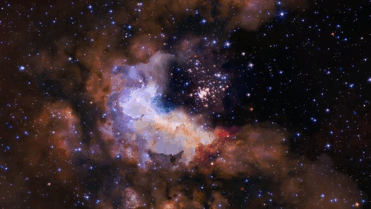
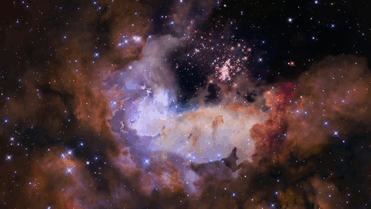
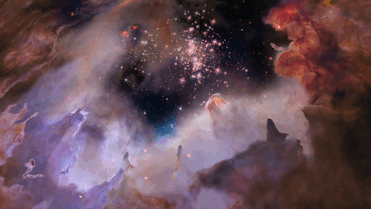
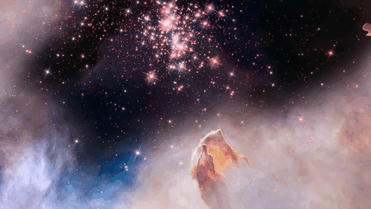
Celestial Fireworks: Into Star Cluster Westerlund 2
What if you could go directly to a cluster where the stars are forming? This animation was done with 3D computer modeling of the region around the star cluster Westerlund 2, based on Hubble Space Telescope images in visible and infrared light. Westerlund 2 covers about 10 light-years and is about 20 thousand light years distant towards the constellation Keel of the ship (Carina). As the illustrative animation begins, the larger Gum 29 nebula fills the screen with the young group of bright stars visible in the center. Stars pass your finger as you approach the cluster. Soon, your imaginary vessel rotates and you pass over the interstellar gas and dust pillars during the light year. Strong winds and radiations from young, massive stars destroy all but the densest clumps of dust, leaving these pillars in their shadows - many pointing back to the center of the cluster. Lastly, you move to the top of the set of stars and search hundreds of the most gigantic stars known.
Credit: NASA, ESA, Hubble, J. Anderson et al. (STScI); Acknowledgment: The Hubble Heritage Team (STScI/AURA), A. Nota (ESA/STScI), the Westerlund 2 Science Team, and the ES
Water, Water Everywhere; We Track Drops to Drink!
When we think about what makes a planet habitable, we’re often talking about water. With abundant water in liquid, gas (vapor) and solid (ice) form, Earth is a highly unusual planet. Almost 70% of our home planet’s surface is covered in water!

But about 97% of Earth’s water is salty – only a tiny amount is freshwater: the stuff humans, pets and plants need to survive.
Water on our planet is constantly moving, and not just geographically. Water shifts phases from ice to water to vapor and back, moving through the planet’s soils and skies as it goes.
That’s where our satellites come in.

Look at the Midwestern U.S. this spring, for example. Torrential rain oversaturated the soil and overflowed rivers, which caused severe flooding, seen by Landsat.

Our satellites also tracked a years-long drought in California. Between 2013 and 2014, much of the state turned brown, without visible green.

It’s not just rain. Where and when snow falls – and melts – is changing, too. The snow that falls and accumulates on the ground is called snowpack, which eventually melts and feeds rivers used for drinking water and crop irrigation. When the snow doesn’t fall, or melts too early, communities go without water and crops don’t get watered at the right time.

Even when water is available, it can become contaminated by blooms of phytoplankton, like cyanobacteria . Also known as blue-green algae, these organisms can make humans sick if they drink the water. Satellites can help track algae from space, looking for the brightly colored blooms against blue water.


Zooming even farther back, Earth’s blue water is visible from thousands of miles away. The water around us makes our planet habitable and makes our planet shine blue among the darkness of space.

Knowing where the water is, and where it’s going, helps people make better decisions about how to manage it. Earth’s climate is changing rapidly, and freshwater is moving as a result. Some places are getting drier and some are getting much, much wetter. By predicting droughts and floods and tracking blooms of algae, our view of freshwater around the globe helps people manage their water.
Make sure to follow us on Tumblr for your regular dose of space: http://nasa.tumblr.com.

The Instrument Deployment Camera (IDC), located on the robotic arm of NASA’s InSight lander, took this picture of the Martian surface on Nov. 26, 2018, the same day the spacecraft touched down on the Red Planet. The camera’s transparent dust cover is still on in this image, to prevent particulates kicked up during landing from settling on the camera’s lens. This image was relayed from InSight to Earth via NASA’s Odyssey spacecraft, currently orbiting Mars.
Credits: NASA/JPL-Caltech

🔭🌃🌌🛰
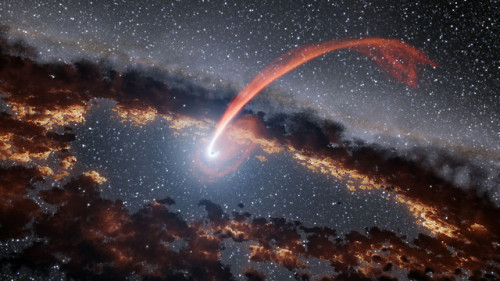
Astronomers Detect Matter Falling into Black Hole
University of Leicester’s Professor Ken Pounds and co-authors report the detection of matter falling into a black hole at 30% of the speed of light.

It is now well established that a supermassive black hole lies in the center of most galaxies, and further that it accretes matter through a disk.
With sufficient matter (interstellar gas clouds or even isolated stars) falling into the black hole, these can become extremely luminous, and are seen as a quasar or active galactic nucleus (AGN).

The orbit of matter around the black hole is often assumed to be aligned with the rotation of the black hole, but there is no compelling reason for this to be the case. In fact, the reason we have summer and winter is that the Earth’s daily rotation does not line up with its yearly orbit around the Sun.
Until now it has been unclear how misaligned rotation might affect the in-fall of matter. This is particularly relevant to the feeding of supermassive black holes since matter can fall in from any direction.

Using data from ESA’s XMM-Newton X-ray Observatory, Professor Pounds and colleagues looked at X-ray spectra from PG1211+143, a Seyfert galaxy (characterized by a very bright AGN resulting from the presence of the massive black hole at its nucleus) located in the constellation Coma Berenices, about one billion light-years away.

The team found the spectra to be strongly red-shifted, showing the observed matter to be falling into PG1211+143’s black hole at the enormous speed of 30% of the speed of light, or around 62,000 miles per second (100,000 km per second).
The gas has almost no rotation around the black hole, and is detected extremely close to it in astronomical terms, at a distance of only 20 times the black hole’s size (its event horizon, the boundary of the region where escape is no longer possible).
“The galaxy we were observing with XMM-Newton has a 40-million-solar-mass black hole which is very bright and evidently well fed,” Professor Pounds said.

“Indeed some 15 years ago we detected a powerful wind indicating the black hole was being over-fed. While such winds are now found in many active galaxies, PG1211+143 has now yielded another ‘first,’ with the detection of matter plunging directly into the black hole itself.”
“We were able to follow an Earth-sized clump of matter for about a day, as it was pulled towards the black hole, accelerating to a third of the velocity of light before being swallowed up by the hole.” source
🔭🌃🌌
Cosmic Alphabet Soup: Classifying Stars

If you’ve spent much time stargazing, you may have noticed that while most stars look white, some are reddish or bluish. Their colors are more than just pretty – they tell us how hot the stars are. Studying their light in greater detail can tell us even more about what they’re like, including whether they have planets. Two women, Williamina Fleming and Annie Jump Cannon, created the system for classifying stars that we use today, and we’re building on their work to map out the universe.

By splitting starlight into spectra – detailed color patterns that often feature lots of dark lines – using a prism, astronomers can figure out a star’s temperature, how long it will burn, how massive it is, and even how big its habitable zone is. Our Sun’s spectrum looks like this:

Astronomers use spectra to categorize stars. Starting at the hottest and most massive, the star classes are O, B, A, F, G (like our Sun), K, M. Sounds like cosmic alphabet soup! But the letters aren’t just random – they largely stem from the work of two famous female astronomers.

Williamina Fleming, who worked as one of the famous “human computers” at the Harvard College Observatory starting in 1879, came up with a way to classify stars into 17 different types (categorized alphabetically A-Q) based on how strong the dark lines in their spectra were. She eventually classified more than 10,000 stars and discovered hundreds of cosmic objects!

That was back before they knew what caused the dark lines in spectra. Soon astronomers discovered that they’re linked to a star’s temperature. Using this newfound knowledge, Annie Jump Cannon – one of Fleming’s protégés – rearranged and simplified stellar classification to include just seven categories (O, B, A, F, G, K, M), ordered from highest to lowest temperature. She also classified more than 350,000 stars!

Type O stars are both the hottest and most massive in the new classification system. These giants can be a thousand times bigger than the Sun! Their lifespans are also around 1,000 times shorter than our Sun’s. They burn through their fuel so fast that they only live for around 10 million years. That’s part of the reason they only make up a tiny fraction of all the stars in the galaxy – they don’t stick around for very long.

As we move down the list from O to M, stars become progressively smaller, cooler, redder, and more common. Their habitable zones also shrink because the stars aren’t putting out as much energy. The plus side is that the tiniest stars can live for a really long time – around 100 billion years – because they burn through their fuel so slowly.

Astronomers can also learn about exoplanets – worlds that orbit other stars – by studying starlight. When a planet crosses in front of its host star, different kinds of molecules in the planet’s atmosphere absorb certain wavelengths of light.
By spreading the star’s light into a spectrum, astronomers can see which wavelengths have been absorbed to determine the exoplanet atmosphere’s chemical makeup. Our James Webb Space Telescope will use this method to try to find and study atmospheres around Earth-sized exoplanets – something that has never been done before.

Our upcoming Nancy Grace Roman Space Telescope will study the spectra from entire galaxies to build a 3D map of the cosmos. As light travels through our expanding universe, it stretches and its spectral lines shift toward longer, redder wavelengths. The longer light travels before reaching us, the redder it becomes. Roman will be able to see so far back that we could glimpse some of the first stars and galaxies that ever formed.
Learn more about how Roman will study the cosmos in our other posts:
Roman’s Family Portrait of Millions of Galaxies
New Rose-Colored Glasses for Roman
How Gravity Warps Light
Make sure to follow us on Tumblr for your regular dose of space!
🌌☄️🌃🍂🍁

2024 August 14
Meteors and Aurora over Germany Image Credit & Copyright: Chantal Anders
Explanation: This was an unusual night. For one thing, the night sky of August 11 and 12, earlier this week, occurred near the peak of the annual Perseid Meteor Shower. Therefore, meteors streaked across the dark night as small bits cast off from Comet Swift-Tuttle came crashing into the Earth’s atmosphere. Even more unusually, for central Germany at least, the night sky glowed purple. The red-blue hue was due to aurora caused by an explosion of particles from the Sun a few days before. This auroral storm was so intense that it was seen as far south as Texas and Italy, in Earth’s northern hemisphere. The featured image composite was built from 7 exposures taken over 26 minutes from Ense, Germany. The Perseids occur predictably every August, but auroras visible this far south are more unusual and less predictable.
∞ Source: apod.nasa.gov/apod/ap240814.html

This photo of Comet Leonard was taken from a remote facility in Namibia.
SpaceWeatherGallery.com/Lukas Demetz / Michael Jaeger
-
 optimistictreefury liked this · 3 months ago
optimistictreefury liked this · 3 months ago -
 edervital liked this · 3 months ago
edervital liked this · 3 months ago -
 hvndrixx reblogged this · 3 months ago
hvndrixx reblogged this · 3 months ago -
 hvndrixx liked this · 3 months ago
hvndrixx liked this · 3 months ago -
 jack-of-all-blades liked this · 3 months ago
jack-of-all-blades liked this · 3 months ago -
 sagewonders reblogged this · 3 months ago
sagewonders reblogged this · 3 months ago -
 justinxlouis liked this · 3 months ago
justinxlouis liked this · 3 months ago -
 thebigsexywizard liked this · 3 months ago
thebigsexywizard liked this · 3 months ago -
 camarajordan liked this · 3 months ago
camarajordan liked this · 3 months ago -
 leighputiya reblogged this · 3 months ago
leighputiya reblogged this · 3 months ago -
 e-koms reblogged this · 3 months ago
e-koms reblogged this · 3 months ago -
 oxinfreee liked this · 3 months ago
oxinfreee liked this · 3 months ago -
 swisher-sweetz liked this · 3 months ago
swisher-sweetz liked this · 3 months ago -
 spicetrix liked this · 3 months ago
spicetrix liked this · 3 months ago -
 no-name-taken liked this · 3 months ago
no-name-taken liked this · 3 months ago -
 sophisticatedexuberance reblogged this · 3 months ago
sophisticatedexuberance reblogged this · 3 months ago -
 slumsaintt reblogged this · 3 months ago
slumsaintt reblogged this · 3 months ago -
 honeyb liked this · 4 months ago
honeyb liked this · 4 months ago -
 amoeba-obscura liked this · 4 months ago
amoeba-obscura liked this · 4 months ago -
 p-l-o-u-fref reblogged this · 6 months ago
p-l-o-u-fref reblogged this · 6 months ago -
 nastycherrytea liked this · 6 months ago
nastycherrytea liked this · 6 months ago -
 r3ddiablo liked this · 6 months ago
r3ddiablo liked this · 6 months ago -
 numbersandstars reblogged this · 6 months ago
numbersandstars reblogged this · 6 months ago -
 ebtrips liked this · 8 months ago
ebtrips liked this · 8 months ago -
 talle91 reblogged this · 8 months ago
talle91 reblogged this · 8 months ago -
 free-style-dreams liked this · 8 months ago
free-style-dreams liked this · 8 months ago -
 beca1959-stuff reblogged this · 8 months ago
beca1959-stuff reblogged this · 8 months ago -
 hrukenshweizer liked this · 8 months ago
hrukenshweizer liked this · 8 months ago -
 sunnycosmology reblogged this · 10 months ago
sunnycosmology reblogged this · 10 months ago -
 looookingup reblogged this · 10 months ago
looookingup reblogged this · 10 months ago -
 breakfasttimesworld reblogged this · 10 months ago
breakfasttimesworld reblogged this · 10 months ago -
 jexert liked this · 10 months ago
jexert liked this · 10 months ago -
 noacarter liked this · 10 months ago
noacarter liked this · 10 months ago -
 drwiseman liked this · 10 months ago
drwiseman liked this · 10 months ago -
 nessieac liked this · 10 months ago
nessieac liked this · 10 months ago -
 le-vent713 liked this · 10 months ago
le-vent713 liked this · 10 months ago -
 carlofaj reblogged this · 10 months ago
carlofaj reblogged this · 10 months ago -
 carlofaj liked this · 10 months ago
carlofaj liked this · 10 months ago -
 radicalcunt reblogged this · 10 months ago
radicalcunt reblogged this · 10 months ago -
 deji404 liked this · 10 months ago
deji404 liked this · 10 months ago -
 redeemedatshawshank liked this · 10 months ago
redeemedatshawshank liked this · 10 months ago -
 dante5043 liked this · 10 months ago
dante5043 liked this · 10 months ago -
 thirdity reblogged this · 10 months ago
thirdity reblogged this · 10 months ago -
 peithointhedark reblogged this · 1 year ago
peithointhedark reblogged this · 1 year ago
My ambition is handicapped by laziness. -C. Bukowski Me gustan las personas desesperadas con mentes rotas y destinos rotos. Están llenos de sorpresas y explosiones. -C. Bukowski. I love cats. Born in the early 80's, raised in the 90's. I like Nature, Autumn, books, landscapes, cold days, cloudy Windy days, space, Science, Paleontology, Biology, Astronomy, History, Social Sciences, Drawing, spending the night watching at the stars, Rick & Morty. I'm a lazy ass.
222 posts
